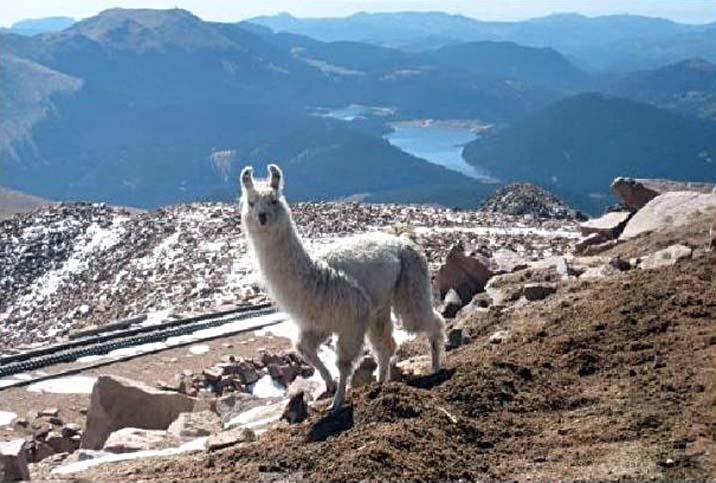The llama has been spotted close to the Pikes Peak Cog Railway tracks - Date unknown Anonymous Photographer - Southwest Llama Rescue. 1 October 2009 Fears Rising for an Escaped Llama
High on Pikes Peak For three weeks, a mysterious visitor has been haunting Pikes Peak, buzzing the trains, amusing the tourists, and confounding efforts to catch it.
For the "lone llama of Pikes Peak," whose species comes from high in the Andes Mountains of South America, the peak must seem like home.
The llama is apparently eating well, though it may be lonely, officials say it has taken an interest in the peak's herd of bighorn sheep.
Sadly for the llama, a herd animal by instinct, that interest has been unrequited.
But with winter coming and hungry mountain lions and coyotes about, some llama lovers say there are bigger threats than loneliness.
A rescue group is trying to coordinate the llama's capture and return it to where it belongs, among a herd.
"Llamas have been domesticated for over 6,000 years," said L'illette Vasquez, state coordinator for Southwest Llama Rescue.
"Although they still have the wild instinct, they are domestic livestock, and they don't have the instinct for survival."
"It's a baby raised on somebody's farm or back yard," she said.
Brent Botts, Pikes Peak district ranger for Pike National Forest, began receiving reports three weeks ago of a llama lingering near the train tracks, high above tree line.
Pikes Peak Cog Railway employees and riders have been noticing the llama since 3 Sep 2009, according to an e-mail one employee sent to the rescue group.
"One of our customers said, is that a sheep, or something like that?" and pointed it out to the conductor, and the conductor went, Oh my God, I've never seen that," said Cog manager Spencer Wren.
The llama seems young and domesticated and it has been shorn, a sign it could be a show llama, Vasquez said.
It frequently runs up to the train and follows it, but backs away from people and keeps returning to the area between Windy Point and the summit, between 13,000 and 14,000 feet.
"This is a pretty llama and it's got that haircut, the shearing that will indicate it's been cared for, it's been with people," she said.
How a domesticated llama came to be on Pikes Peak is a mystery.
Botts said it could have run away from hikers using it as a pack animal.
Vasquez suspects it jumped from a trailer of someone passing through and kept going up the mountain.
The llama has gotten within 30 feet of the Cog, and some employees recently helped a Pikes Peak Highway ranger try to lasso it, but the animal got spooked and ran off, Wren said.
Last weekend, Black Forest llama farm owner Mike Shealy took one of his llamas to the mountain, in hopes the "lone llama" would see another of its kind, herd instincts would kick in, and it would come to him.
"Llamas are real herd-oriented animals. I, numerous times, have caught an animal that has been out away from the gang," Shealy said.
"They just will run to the other one. It's really easy to catch them, if they see each other."
He didn't see the llama, though he did see encouraging signs, including tracks, running water for it to drink, and ample alpine vegetation for it to eat.
"He's not starving. The sheep are eating the same thing that he is, and they are fat and sassy," said Shealy, who doesn't actually know the llama is a "he."
Shealy spent about five hours on the peak's upper slopes.
He plans to return Friday with more llamas to entice the "lone llama" from its mountain repose.
Vasquez, meanwhile, has put the word out to llama owners and groups across the country, hoping someone will claim it.
Llamas can be worth from about US$250 to thousands of dollars, she said.
Other concerns are that, as domestic livestock, it could spread disease to the bighorns, or unlikely, given that is is the "lone llama", breed in the wild.
Said Botts, the district ranger, "It's not a native species, so it's probably best it goes where it belongs."
"It's just hard to believe that somebody is not missing a llama."
R. Scott Rappold.    |


